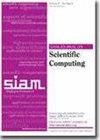pISTA: Preconditioned Iterative Soft Thresholding Algorithm for Graphical Lasso
IF 3
2区 数学
Q1 MATHEMATICS, APPLIED
引用次数: 0
Abstract
SIAM Journal on Scientific Computing, Ahead of Print.Abstract. We propose a novel quasi-Newton method for solving the sparse inverse covariance estimation problem also known as the graphical least absolute shrinkage and selection operator (GLASSO). This problem is often solved using a second-order quadratic approximation. However, in such algorithms the Hessian term is complex and computationally expensive to handle. Therefore, our method uses the inverse of the Hessian as a preconditioner to simplify and approximate the quadratic element at the cost of a more complex [math] element. The variables of the resulting preconditioned problem are coupled only by the [math] subderivative of each other, which can be guessed with minimal cost using the gradient itself, allowing the algorithm to be parallelized and implemented efficiently on GPU hardware accelerators. Numerical results on synthetic and real data demonstrate that our method is competitive with other state-of-the-art approaches.
pISTA:图形套索的预处理迭代软阈值算法
SIAM 科学计算期刊》,提前印刷。 摘要我们提出了一种新颖的准牛顿方法来解决稀疏逆协方差估计问题,该问题也被称为图形最小绝对收缩和选择算子(GLASSO)。该问题通常采用二阶二次近似法求解。然而,在这种算法中,赫塞斯项的处理非常复杂,计算成本高昂。因此,我们的方法使用 Hessian 逆作为预处理,以更复杂的[数学]元素为代价,简化和近似二次元素。由此产生的预处理问题的变量仅由彼此的[math]次减数耦合,可以使用梯度本身以最小的成本猜测,从而允许算法并行化,并在 GPU 硬件加速器上高效实现。合成数据和真实数据的数值结果表明,我们的方法与其他最先进的方法相比具有竞争力。
本文章由计算机程序翻译,如有差异,请以英文原文为准。
求助全文
约1分钟内获得全文
求助全文
来源期刊
CiteScore
5.50
自引率
3.20%
发文量
209
审稿时长
1 months
期刊介绍:
The purpose of SIAM Journal on Scientific Computing (SISC) is to advance computational methods for solving scientific and engineering problems.
SISC papers are classified into three categories:
1. Methods and Algorithms for Scientific Computing: Papers in this category may include theoretical analysis, provided that the relevance to applications in science and engineering is demonstrated. They should contain meaningful computational results and theoretical results or strong heuristics supporting the performance of new algorithms.
2. Computational Methods in Science and Engineering: Papers in this section will typically describe novel methodologies for solving a specific problem in computational science or engineering. They should contain enough information about the application to orient other computational scientists but should omit details of interest mainly to the applications specialist.
3. Software and High-Performance Computing: Papers in this category should concern the novel design and development of computational methods and high-quality software, parallel algorithms, high-performance computing issues, new architectures, data analysis, or visualization. The primary focus should be on computational methods that have potentially large impact for an important class of scientific or engineering problems.

 求助内容:
求助内容: 应助结果提醒方式:
应助结果提醒方式:


